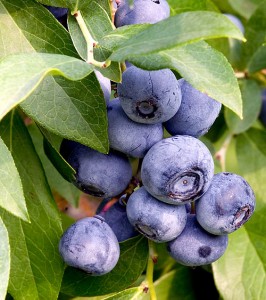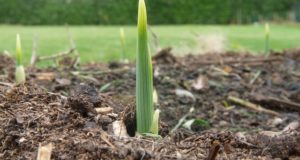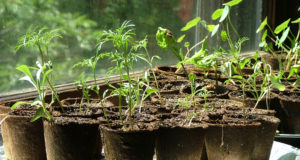 Blueberries are high in vitamin C and are very versatile; they make great pies, preserves, juice, or can be eaten right from the bush. Blueberries are among the easiest berries to grow, but soil preparation is crucial to a good crop. They grow best in sandy, well-drained soil rich in organic material with a pH level between 4.0 and 5.2. Soil should be prepared well in advance, at least two weeks before planting your bushes, but some say that preparing the season before is best. (That means that now may be a great time to get ready to grow!)
Blueberries are high in vitamin C and are very versatile; they make great pies, preserves, juice, or can be eaten right from the bush. Blueberries are among the easiest berries to grow, but soil preparation is crucial to a good crop. They grow best in sandy, well-drained soil rich in organic material with a pH level between 4.0 and 5.2. Soil should be prepared well in advance, at least two weeks before planting your bushes, but some say that preparing the season before is best. (That means that now may be a great time to get ready to grow!)
Choosing Your Bushes:
When choosing your blueberry bushes, there are several things to be considered: the size of the bushes, the amount of space required, the height at maturity, and the amount of cold they can endure. Each variety will have choices in several categories to consider when making your choice, so review all characteristics before making your choices. There are early, midseason, and late-blooming bushes in each variety; there are also a vast array of berry sizes and flavors to choose from. Whatever variety choice you make, it is a good idea to pick bushes that have overlapping blooming periods to extend your harvest.
Blueberry Varieties:
Northern Highbush
Aurora, Bluecrop, Bluegold, Bluejay, Blueray, Chandler, Darrow, Draper, Duke, Elliot, Earliblue, Hardyblue, Jersey, Legacy, Liberty, northern, Patriot, Reka, Rubel, Spartan, Toro
Hardy zones 3 – 7
800 – 1000 chill hours (high chill)
Mature size: 4 to 10 feet
Southern Highbush
Emerald, Jewel, Jubilee, Misty, Southmoon, O’Neal, Sharpblue, Star, Sunshine Blue
Hardy zones 5-10
150 – 800 chill hours (low chill)
Mature size: 3 to 8 feet high
Lowbush
Brunswick Blueberry, Top Hat
Hardy zones 3 – 7
Most cold hardy of all blueberries
Mature size: 1 to 3 feet high. Spreads 1 to 2 feet
Half-high (cross between Highbush and Lowbush varieties)
Northblue, Northsky
Hardy zones 3 – 7
Mature size: 1 to 3 feet. Spreads 2 to 6 feet
Site Selection:
Blueberries require full sun at least six to eight hours daily. Verify how much sun your site gets by carefully watching the area and timing when it has full sun or by purchasing a sun calculator to determine the blueberries are getting enough sun. You also need to determine the berries aren’t in a “frost pocket.” These tend to be in wooded, low-lying areas where cold air tends to collect. Higher areas that slope gently will have better air circulation and will be less prone to spring frost damage. Air movement may also suppress some fungal diseases and will provide better picking conditions during hot weather.
Soil Preparation:
Blueberries require sandy, well-drained soil rich in organic material with a pH between 4.0 and 5.2, but they perform best when the pH is 4.6 to 4.8. It must be prepared well before planting. Lower the pH level by adding four to six inches of peat moss to the top six to eight inches of soil. This will acidify the soil and also increase the organic material. Along with (or instead of) adding peat moss, add pine needle mulch or untreated pine wood sawdust or shavings. As they decompose, they will lower the pH level of the soil. After amending soil but before planting, retest to ensure that pH is right for your plants.
Most soils have a pH that is too high. A pH of 7 is considered neutral, lower than 7 is acidic, and above 7 is alkaline. When the pH is too high, blueberry bushes will turn yellow. If too high for long periods it can stunt growth, lessen production and eventually kill the plants. If your pH is 7.0 or higher, or if you don’t want to worry about testing and correcting the pH, then raised beds or large containers are the way to go. Here is simple soil recipe for raised beds or containers. Simply mix well and add to your bed or container.
- 1/3 quarter-inch pathway bark
- 1/3 peat moss
- 1/3 organic azalea mix (or acid plant mix made from forest byproduct-based potting soil)
- 1 handful soil sulfur per plant
Caring for Your Blueberries:
During the first year of growth blueberries, need extra care to get them well established. Along with soil preparation, watering, and mulching, you need to remove all the blossoms. This forces plants to spend their energy on making a sturdy root system and strong branches. Doing this will bring a higher yield and larger, healthier bushes the second year.
When planted in containers, they should remain outside to overwinter. Move them close to a building to protect them from wind and weather damage. During the growing season, they should be placed in full sun eighteen to thirty-six inches apart. That’s far enough to allow growth, but close enough for pollination. In winter they won’t need much water, but don’t let them completely dry out.
Watering:
Blueberries require one inch of water weekly. Watering deeply two to three times each week for longer periods is better than watering lightly every day. Soils rich in organic matter will help retain moisture. Adding mulch around the bushes six to eight inches beyond the foliage will also retain moisture. Mulch also deters weed growth, which is as important as having plenty of water. Blueberries have shallow roots and will not thrive if the have to fight with weeds for water and nutrients.
Fertilizing:
Fertilizing should be done when buds first swell in spring and again when fruit is setting. Fertilize with organic, acidic fertilizer, like Dr. Earth Organic 4, Down to Earth Organic Acid Fertilizer, or other organic fertilizers for acid-loving plants.
Pruning:
Remove all dead, diseased, or damaged canes and twiggy growth each spring. This will open the center of the bushes to permit sunlight and fresh air to reach all branches, thus making them all strong and healthy.
Pollination:
To insure proper pollination, you will need to plant at least two bushes. Having three is even better. They will need to be planted fairly close. Check for planting directions for the bushes you choose.
©2011 Off the Grid News
 Off The Grid News Better Ideas For Off The Grid Living
Off The Grid News Better Ideas For Off The Grid Living



